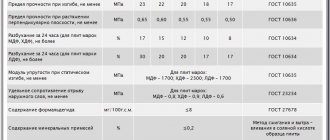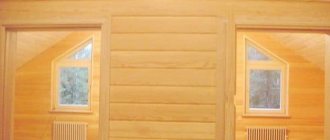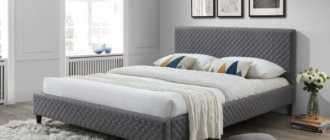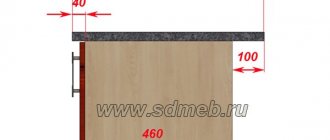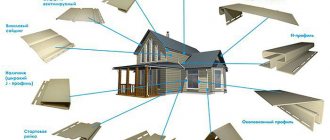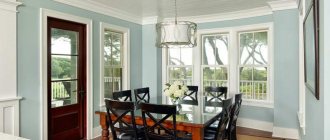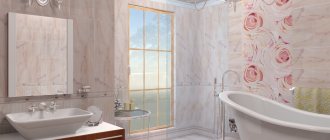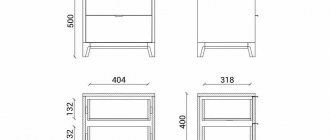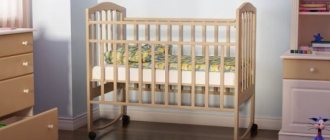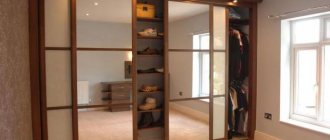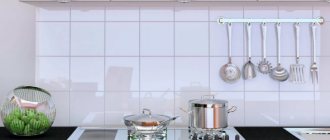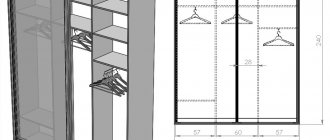Today, the Russian market of sheet construction and finishing materials offers medium-density fiberboards from both domestic and foreign manufacturers. The most widespread products are from brands such as:
- Kronospan (Russia, Yegoryevsk);
- Kronostar (Russia, Sharya);
- Shekninsky control center (Russia, Vologda region)
- Glunz AG (Germany);
- EGGER (Austria);
- Korosten MDF plant (Ukraine).[contents]
What kind of material is this? Decoding the abbreviation
MDF is an abbreviation that comes from the English language. Literally translated, the name of the material sounds like MEDIUM DENSITY FIBERBOARD. The first letters of these words served as the basis for the creation of a familiar colloquial term. Translated into Russian, the name of the material stands for medium-density fiberboard.
Composition and Characteristics
In terms of its structure, MDF is a wood fiber board consisting of crushed sawdust. During the manufacturing process, the raw materials are cleared of sawdust and converted into a powder state. Then the resulting composition is treated with steam and an adhesive base is added: lignin and paraffin.
Among the main advantages of MDF are the following characteristics:
- Resistance to dynamic loads. To break an MDF panel, a force of 15 MPa must be applied. According to mechanical properties. The material is significantly superior to solid wood.
- Environmental Safety. The release of formaldehyde from the panels must meet the requirements:
Test method Release rate into air Purpose of tests Chamber method according to GOST 30255-95 no more than 0.124 mg/m3 air Qualification and control periodic tests Gas analysis method according to GOST 53867-2010 no more than 3.5 mg/m2 per hour Production control - Reliability. The material has increased moisture resistance, is absolutely neutral to temperature changes and direct sunlight.
- Easy to process. With high strength, MDF is easy to process; if desired, you can decorate the panel with decorative cuttings.
- Density. MDF from 600 to 850 kg/cub.m. Fiberboard is also produced in low density (LDF) from 200 to 600 kg/m3 and high density (HDF) over 800 kg/m3 .
It is worth noting that fungus and mold do not appear on the slabs.
High Density Material and Its Applications
High density MDF is similar to its low and medium density counterparts. This material has high strength and is therefore more reliable. The standard thickness is 4 millimeters. Such plates are used to achieve the following purposes:
- leveling walls;
- floor coverings;
- production of interior doors;
- carriage building;
- when lining the car interior;
- manufacturing of trade and exhibition equipment;
- hide communications if necessary.
MDF or PVC: which is better?
It’s worth clarifying right away that two finishing materials (MDF and PVC) are widely used in home construction and have no complaints about quality. Therefore, when choosing, you need to focus on the area of application. For example: MDF is considered more environmentally friendly, so it will be suitable for decorating a nursery or living room without any problems. PVC is impervious to any aggressive influences, so it is often used to decorate bathrooms and kitchens.
It is worth noting that PVC has minimal weight, so when installing it is quite possible to do it yourself. However, this material is very susceptible to mechanical damage, so even a slight blow can damage the surface. MDF is more resistant to external influences, but it cannot remain in a humid environment for a long time.
Tips for cutting
When you already know the density of MDF, you can study tips on cutting the material. It is best to purchase products with standard sizes and factory processing. If there is a need to carry out sawing, it is better to entrust this to specialists. In this case, special format-cutting machines are used.
Craftsmen know that workpieces are laid with the back side up if cutting is carried out on a machine. When starting the saw, the movement of the plates should be progressive and smooth. The teeth are immersed by 1 mm. Proper cutting allows you to obtain precise workpieces to the required dimensions. This process is labor-intensive, but allows you to obtain parts for making furniture and doors.
Types of wood-fibrous material
There are many varieties of MDF on the domestic market, so problems with choosing a finishing option usually do not arise. The assortment of construction stores usually includes the following categories:
- Laminated . A special film is applied to the surface, which gives standard panels different shades. The surface can be matte or glossy.
- Veneered . This is quite expensive material. Here, veneer made from valuable wood species is glued to both sides of the panel.
- For painting . This is a special type of MDF designed for self-painting. The surface is coated with a special compound that ensures adhesion to dyes.
- Wall panels . Such products are very convenient in terms of installation for interior decoration. A “groove-lock” fastening system is used here, which ensures reliable adhesion of the elements to each other. It is worth noting that the wall panels are attached with a stapler or glue.
- Moisture resistant . This material is impregnated with a special composition, so it can remain in high humidity conditions for a long time. In their properties, such panels are very similar to PVC.
- Flexible . The material is resistant to dynamic loads, so it can bend without receiving mechanical damage. Typically, such panels are used when decorating arches.
MDF boards are used to make interior doors, decorative kitchen splashbacks and cabinet furniture facades. External parameters depend on the type of application.
Manufacturers: Korostensky plant
This plant, the largest in Ukraine, operates on the most modern German equipment. Siempelkamp offers high-tech machines of the latest generation. Quality control is mandatory here at every stage of production.
German settings exactly:
- determine the quantity and weight of all components for the future MDF carpet;
- control the temperature during the production of slabs and panels;
- measure the dimensions of the finished product;
- select the color as efficiently as possible;
- carefully laminate the compressed material.
All this together allows the plant, which, by the way, is located in the Zhytomyr region, to produce competitive goods. All indicators of finished products meet European quality standards. This allows you to send MDF for export and continue to increase your turnover.
The Korosten plant specializes not only in the production of MDF, but also produces laminate. The company's products are popular and deserve only high praise. The production line represents products that you can choose for your needs. But if necessary, finished MDF boards can be cut.
The video will tell you about all the stages of the production process of MDF and HDF boards:
dimensions
Depending on the area of application of MDF, the dimensions of the facing material also change. Here you can derive the following standards:
- Wall panels. The standard length of the wall panel is 2.62 meters, however, some manufacturers produce products with lengths 2.44 and 2.8 m. Width may vary within 100-900 mm. Panels are divided into types depending on width P-1, P-2, P-3, P-4, P-5 (100, 125, 150, 175, 250). With panel thickness 3-30 mm. The thickness of veneered MDF can reach 60 mm.
Compliance with quality requirements:Specific resistance during normal coating separation. MPa, not less 0,4 Coating abrasion resistance, rpm, not less 30 Hardness of protective and decorative coating, microns. no more 120 Warping, µm/m, no more 1.5 - Plates . The length of the material is usually about 1.5 meters , width - 100-900 mm . The thickness of MDF boards varies between 6-24 mm .
- Facades . Considering the various options and dimensions of furniture, there are no strictly defined standards. The following parameters can be considered as a basis: thickness 16 mm , height 140-934 and width 296-596 mm .
- Aprons . For the manufacture of decorative aprons, furniture panels are usually used, which have the following characteristics: length - 3,000 , width - 600 and thickness 6-10 mm .
- Countertops . This element must be resistant to dynamic loads, so the following dimensions are used here: length - 1,000 , width - 600 and thickness 28-38 mm .
- Doors . MDF doors are usually made according to the following standard: thickness - 35-45 mm , height - 190-200 cm , width - 70-90 cm . Read more about door and opening dimensions >>>
It is worth noting that the dimensions given may vary depending on the manufacturer.
Table of parameters of polished sheets.
| Manufacturer country | Dimensions (mm) | Sheet thickness (mm) | Density (kg/m³) | Sheet weight (kg) |
| Russia | 2440×2050 | 3 | 840 | 13 |
| Russia | 2440×1830 | 3 | 840 | 12 |
| Ukraine | 2800×2070 | 3 | 780 | 15 |
| Russia | 2800×2070 | 6 | 750 | 26 |
| Ukraine | 2800×2070 | 6 | 780 | 27 |
| Germany | 2620×2070 | 6 | 800 | 26 |
| Russia | 2800×2070 | 8 | 750 | 35 |
| Ukraine | 2800×2070 | 8 | 780 | 36 |
| Germany | 2620×2070 | 8 | 800 | 35 |
| Russia | 2440×1830 | 10 | 800 | 36 |
| Russia | 2800×2070 | 10 | 750 | 43 |
| Ukraine | 2800×2070 | 10 | 770 | 45 |
| Germany | 2620×2070 | 10 | 790 | 43 |
| Russia | 2800×2070 | 12 | 750 | 52 |
| Ukraine | 2800×2070 | 12 | 770 | 54 |
| Germany | 2620×2070 | 12 | 790 | 51 |
| Russia | 2440×1830 | 16 | 800 | 57 |
| Russia | 2800×2070 | 16 | 750 | 70 |
| Ukraine | 2800×2070 | 16 | 770 | 71 |
| Germany | 2620×2070 | 16 | 790 | 69 |
| Russia | 2440×1830 | 18 | 800 | 64 |
| Russia | 2800×2070 | 18 | 730 | 76 |
| Ukraine | 2800×2070 | 18 | 750 | 78 |
| Germany | 2620×2070 | 18 | 770 | 75 |
| Russia | 2800×2070 | 19 | 730 | 80 |
| Ukraine | 2800×2070 | 19 | 750 | 83 |
| Germany | 2620×2070 | 19 | 770 | 79 |
| Russia | 2800×2070 | 22 | 730 | 93 |
| Ukraine | 2800×2070 | 22 | 750 | 96 |
| Germany | 2620×2070 | 22 | 770 | 92 |
| Russia | 2440×1830 | 24 | 800 | 86 |
| Russia | 2800×2070 | 25 | 730 | 106 |
| Ukraine | 2800×2070 | 25 | 750 | 109 |
| Germany | 2620×2070 | 25 | 770 | 104 |
| Russia | 2800×2070 | 28 | 720 | 117 |
| Ukraine | 2800×2070 | 28 | 740 | 120 |
| Germany | 2620×2070 | 28 | 750 | 114 |
| Russia | 2800×2070 | 30 | 720 | 125 |
| Ukraine | 2800×2070 | 30 | 740 | 129 |
| Germany | 2620×2070 | 30 | 750 | 122 |
| Germany | 2620×2070 | 38 | 750 | 155 |
| Germany | 2620×2070 | 40 | 750 | 163 |
| Germany | 2800×2070 | 40 | 740 | 172 |
Table of parameters of laminated sheets.
| Manufacturer country | Dimensions (mm) | Thickness (mm) | Number of laminated sides | Weight, kg) |
| Russia Ukraine | 2800×2070 | 16 | 1 | 74 |
| Russia Ukraine | 2800×2070 | 16 | 2 | 74 |
| Russia Ukraine | 2800×2070 | 19 | 1 | 88 |
| Russia Ukraine | 2800×2070 | 19 | 2 | 88 |
| Germany | 2620×2070 | 10 | 1 | 43 |
| 2620×2070 | 16 | 1 | 69 | |
| 2620×2070 | 18 | 1 | 78 | |
| 2620×2070 | 19 | 1 | 82 | |
| 2620×2070 | 22 | 1 | 95 |
Table of parameters of sheets laminated with paper film.
| Dimensions (mm) | Thickness (mm) | Weight, kg) |
| 3 | 2440×1830 | 11 |
| 4 | 2440×1830 | 14 |
| 6 | 2440×1830 | 21 |
| 6 | 2800×1830 | 25 |
| 8 | 2800×1830 | 33 |
| 10 | 2440×1830 | 36 |
| 10 | 2800×1830 | 41 |
| 12 | 2800×1830 | 49 |
| 16 | 2440×1830 | 57 |
| 16 | 2800×1830 | 66 |
| 18 | 2440×1830 | 64 |
| 18 | 2800×1830 | 74 |
| 19 | 2800×1830 | 78 |
| 22 | 2800×1830 | 90 |
| 24 | 2440×1830 | 86 |
| 25 | 2800×1830 | 102 |
MDF weight
The external dimensions and thickness of the panel play a key role. Weight according to dimensions is given in the tables above. Let's see how the weight of an MDF panel measuring 2,800*2,050 mm (the maximum value on the market) will change, depending on the thickness of the product:
- 3 mm – 16 kg.
- 6 mm – 31 kg.
- 12 mm – 60 kg.
- 22 mm – 106 kg.
- 28 mm – 142 kg.
It is worth noting that the weight of the decorated panels will vary slightly upward.
Length
The typical length of a wall panel is 2.62 m, while some manufacturers have launched products with lengths of 2.44 and 2.8 meters.
The parameters and sizes of the boards vary depending on the MDF manufacturer. So, for example, the popular brand Kronospan produces panels in sizes 2600X200 mm, 2600X325 mm, 2600X153 mm and 2600X200 mm.
The world-famous manufacturer HDM offers panels with parameters of 1300X198 mm and 2600X198 mm. Finally, the Russian one produces panels in a single size 2600X238.
Each manufacturer (within its size range) produces a wide variety of panels, differing in texture and color.
Standard panel colors. Texture
Thanks to modern technologies, you can choose the shade of MDF panels to suit any interior design. In particular, on the market there are textures like stone, natural wood, imitation metal surfaces, copper, silver and mother-of-pearl.
However, the most recognized are the standard MDF colors that imitate solid wood. Here you can select the following colors:
- Apple tree
- Nut
- Ash
- Cedar
- Bleached oak
- Cherry
- Ash
Such panels accurately imitate wood and are suitable for finishing any interior space.
How to paint?
If necessary, you can refresh your boring interior by repainting the surface in a different color. It is worth clarifying that the procedure is quite complicated, but quite doable on your own. Here are the following stages:
- Prepare the dye. The best option for painting MDF would be to mix paint and hardener in a ratio of 1:9, respectively. To prevent the composition from hardening, regular stirring is required.
- The basis. The panels must be sanded and primed. The thickness of the primer layer should vary between 100-140 microns. The primer usually dries within 2-6 hours.
- Painting. At this stage, several layers of paint are applied, each thickness is about 80 microns. The finishing layer can be polished to give the surface a glossy finish.
- Drying. For the dye to “adhere”, it is necessary to keep the painted panel for 8-12 hours at room temperature.
If we talk about paint, then the following emulsions are suitable for MDF:
- Alkyd or oil based.
- Contains polyurethane resins.
- Nitro paint of NC category.
- Aerosols on acrylic base.
In addition, special enamels for painting MDF are sold.
Tips for DIY Coloring
MDF boards are well suited for kitchen furniture and are used as an alternative to plastic. You can purchase a kitchen made of MDF with photo printing, but if finances do not allow, then you can paint the surface of the slab in the color that you prefer. In this case, you need to adhere to a certain algorithm of actions. At the first stage, the surface is well cleaned, washed and sanded.
Then you need to wipe it with a solvent. At the next stage, the primer is applied in 2 layers with a break for drying. Using a brush or balloon, a layer of paint is applied to the surface. You can use a spray gun, it will cost more, but the result will be better. After the paint has dried, you can apply a layer of varnish on top, which will add shine to the product and perform a protective function.
Accessories. Clamps for fastening panels
What is a gluer for MDF? Essentially, it is a small metal plate that is used during the installation process. The clamps are inserted into special grooves and screwed to the sheathing with self-tapping screws. The result is a reliable mount that remains hidden after installation work is completed.
The clamps are marked with numerical indices from 1 to 6. The marking is deciphered as follows: this is the distance from the base of the part to the locking tongue in millimeters. When installing wall panels, clamps with the index “2” are used, however, everything depends on the specific thickness of the material.
